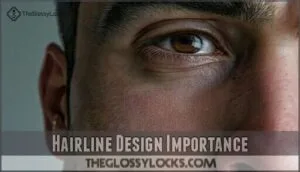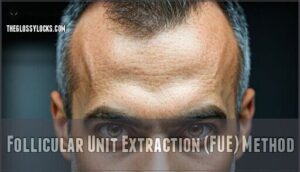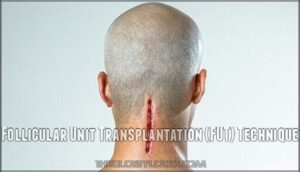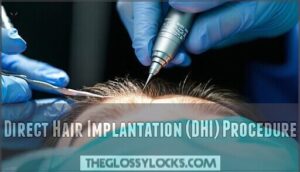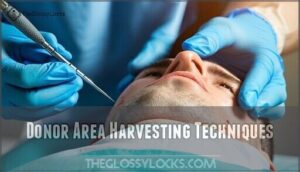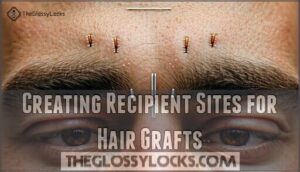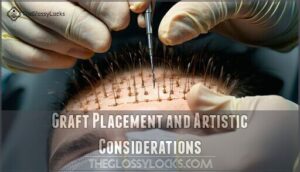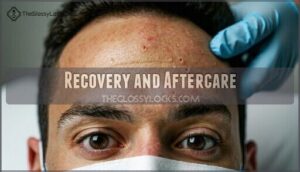This site is supported by our readers. We may earn a commission, at no cost to you, if you purchase through links.
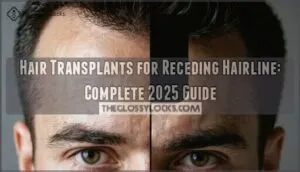
Modern techniques like FUE and FUT move healthy follicles from your donor area to thinning spots, achieving 97% success rates.
You’ll see 10-80% of transplanted hair growing back within 3-4 months, creating natural-looking results that last a lifetime.
The procedure works by relocating DHT-resistant follicles to areas affected by male pattern baldness, basically giving you back the hairline you once had.
Recovery takes about 7-10 days, with most people returning to work within a week.
The key lies in choosing the right technique, finding an experienced surgeon, and understanding what realistic outcomes look like for your specific case.
Table Of Contents
- Key Takeaways
- Hair Transplant Basics
- Causes of Receding Hairline
- Hairline Design Importance
- Top 5 Hair Transplant Products
- Hair Transplant Techniques
- Planning and Preparation
- Hair Transplant Procedure
- Recovery and Aftercare
- Cost and Alternatives
- Frequently Asked Questions (FAQs)
- Can hair transplants fix receding hairlines?
- Can a hair transplant regrow the hairline?
- Is 1500 grafts enough for a hairline?
- Can hair regrow on a receding hairline?
- Do hair transplants fix receding hairlines?
- How much do hair transplants cost for receding a hairline?
- Can hair regrow on receding hairline?
- Do hairline transplants last?
- Can I dye my hair after a transplant?
- Will a hair transplant affect future hair loss?
- Conclusion
Key Takeaways
- Modern techniques work well – FUE and FUT methods achieve 97% success rates by moving DHT-resistant follicles from your donor area to thinning spots, giving you permanent results that last decades.
- You’ll see gradual improvement – Expect 10-80% of transplanted hair to grow back within 3-4 months, with full results appearing at 10-12 months as your new hairline takes its final shape.
- Recovery’s manageable – You’ll need about 7-10 days for initial healing, with most people returning to work within a week, though you’ll need to follow specific aftercare instructions for best results.
- Cost varies by technique and location – Expect to pay $4,000-15,000, depending on your chosen method, with FUE costing more than FUT but offering minimal scarring and faster recovery times.
Hair Transplant Basics
If you’re considering a hair transplant for your receding hairline, understanding the basic techniques will help you make an informed decision.
Modern hair restoration offers proven methods like FUE and FUSS, each with distinct advantages for creating natural-looking results.
Follicular Unit Strip Surgery (FUSS)
FUSS involves removing a strip of scalp from your donor area, then transplanting individual follicular units to your receding hairline.
This hair restoration technique offers excellent graft yield but creates linear scarring that requires careful donor closure consideration.
FUSS Procedure Elements:
- Linear Scarring – Single horizontal scar hidden by surrounding hair growth
- Scalp Laxity – Surgeon assesses skin elasticity for ideal donor closure
- Graft Yield – Higher follicle survival rates compared to other methods
- FUT Revision – Future procedures can address or refine initial results
Follicular Unit Extraction (FUE)
FUE transplant offers you greater freedom in hairstyle choices since it leaves only small, dot-like scars instead of a linear mark.
This follicular unit extraction method carefully removes individual hair follicles from your donor area, though it’s pricier than strip surgery.
Robotic FUE systems boost precision while DHI benefits include immediate implantation.
FUE longevity matches traditional methods, making it ideal for receding hairline restoration when you want minimal FUE scarring.
Recovery Time and Process
Your hair transplant recovery unfolds in predictable phases.
Initial Post-Op brings mild swelling and scabbing for 1-2 weeks.
Shock Loss occurs at 2-4 weeks when transplanted hairs temporarily shed.
Early Growth starts at 3-4 months with fine new strands emerging.
Visible Progress becomes apparent at 6-9 months as your hairline takes shape.
Final Results appear at 10-12 months with full density achieved.
Causes of Receding Hairline
Understanding why your hairline recedes helps you make informed decisions about treatment options.
Most hairline recession stems from genetic predisposition combined with hormonal changes, particularly sensitivity to dihydrotestosterone (DHT) that gradually weakens hair follicles over time, leading to a condition often associated with dihydrotestosterone (DHT).
Genetic Factors in Hair Loss
Your genetic blueprint largely determines whether you’ll face male pattern baldness, with specific genes controlling your hair follicles’ sensitivity to DHT.
Your DNA essentially decides whether you’ll lose hair, determining how sensitive your follicles are to hormones that cause balding.
Family history offers the clearest prediction of your future hairline.
Here are five key genetic factors influencing hair loss:
- DHT sensitivity genes – Inherited variations determine how your follicles respond to dihydrotestosterone
- Baldness genes from both parents – Your mother’s X chromosome carries essential hair loss markers
- Family history patterns – Examining relatives reveals your likely progression timeline
- Inheritance patterns across generations – Androgenetic alopecia follows predictable genetic pathways
- Genetic testing availability – Modern DNA analysis can predict your receding hairline risk
Understanding your genetic predisposition helps you make informed decisions about hair transplant timing and expectations for treating male pattern baldness effectively.
Hormonal Influences on Hairline Recession
Beyond genetics, hormones play a starring role in your hairline’s retreat.
DHT sensitivity determines how your follicles respond to dihydrotestosterone, the primary culprit behind male pattern baldness and androgenetic alopecia.
Fluctuating estrogen levels, thyroid impact, and stress hormones create a perfect storm for hair loss.
Understanding these hormonal changes helps you target effective hormonal therapies for your receding hairline.
| Hormone | Effect on Hairline | Treatment Options |
|---|---|---|
| DHT | Shrinks follicles, causes pattern baldness | Finasteride, dutasteride blockers |
| Estrogen | Low levels accelerate hair loss | Hormone replacement therapy |
| Thyroid | Imbalances trigger diffuse thinning | Thyroid medication adjustment |
| Cortisol | Chronic stress disrupts growth cycles | Stress management, lifestyle changes |
| Testosterone | Converts to DHT in sensitive follicles | Anti-androgen treatments |
Stages of Male Pattern Baldness
Male pattern baldness follows a predictable path called the Norwood Scale, which maps seven distinct stages of hair loss progression.
You’ll notice early signs like temple recession and crown thinning before experiencing more advanced balding patterns.
Understanding your current stage helps determine ideal treatment timing and realistic expectations.
The psychological impact often motivates men to seek hair transplant solutions during stages 2-4, when intervention typically yields the best results for receding hairline restoration.
Hairline Design Importance
When you’re getting a hair transplant for your receding hairline, the design isn’t just about adding hair—it’s about creating a natural frame for your face that you’ll be happy with for years to come.
Your surgeon must carefully consider your facial proportions, age, and personal style to craft a hairline that looks like it was always meant to be there, creating a look that is both aesthetically pleasing and personal.
Facial Proportions and Symmetry
Successfully creating a natural-looking hairline requires careful attention to facial proportions and symmetry.
Your surgeon will use the Golden Ratio to determine ideal hairline placement, ensuring facial harmony between your forehead, eyebrows, and nose.
This mathematical approach prevents an unnatural appearance while addressing temple recession and maintaining proper hairline shape, whether you have a widow’s peak or prefer straight edges, to achieve overall facial harmony.
Natural Irregularity and Hair Density
Your surgeon won’t create a perfectly straight hairline because that’s not how nature works.
Real hairlines have irregular placement and density gradients that make them look authentic. Hair transplant specialists use follicular distribution techniques that mimic nature’s randomness, placing grafts at varying angles and densities.
This irregular placement prevents the telltale "pluggy" look of older hair transplant methods, ensuring your new hairline blends seamlessly with existing hair.
Temple Points and Side Transitions
Temple points need precise positioning to avoid unnatural straight lines across your forehead.
Your surgeon will create subtle recession at these corners, matching your original hairline’s natural contours.
Blending techniques guarantee smooth density gradients from temples to central areas.
Angle variations in graft placement mirror natural growth patterns, while strategic temporal recession maintains masculine aesthetics without harsh transitions.
A key aspect of achieving a natural look is to confirm a seamless beard blend, ensuring smooth density gradients and natural growth patterns are maintained, which helps in achieving a natural look.
Top 5 Hair Transplant Products
When you’re researching hair transplant procedures, you’ll encounter various tools and resources designed to help patients and surgeons achieve better results.
These products range from specialized surgical instruments to thorough guides that walk you through the entire process, including destination-specific information for popular hair transplant locations like Turkey.
1. Seamless Hair Transplant Extractor Machine
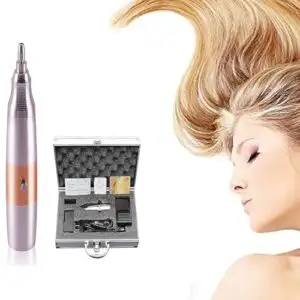
Revolutionary technology meets precision in this seamless hair transplant extractor machine that’s changing how surgeons approach follicle harvesting.
You’ll benefit from its 3-speed adjustable gear design that maximizes hair follicle use with an impressive 95% transplantation success rate.
The device utilizes small round extraction tools that avoid linear scarring while ensuring safe, natural hair regrowth.
Considering other options, some patients explore low level laser therapy as well.
What sets this machine apart is its ability to harvest follicles from multiple donor areas including your scalp, beard, arms, chest, and legs, giving you more options for extensive coverage when dealing with extensive hair loss.
Best For: Individuals seeking a minimally invasive, high-precision hair restoration solution with versatile donor options and a strong success rate.
- Needle length is non-adjustable, limiting customization for unique hair or skin types.
- High-tech system may increase upfront cost compared to conventional methods.
- Requires specialized training for optimal use and benefit from advanced features.
- Customizable 3-speed extraction maximizes hair follicle viability with up to 95% transplantation success.
- Minimally invasive, avoids linear scars, and allows for natural-looking regrowth from multiple donor sites.
- AI and AR integration boosts precision, workflow efficiency, and overall patient safety.
2. Hair Follicle Extraction Transplantation Tool

Professional hair follicle extraction tools operate at variable speeds from 0-20,000 RPM, giving you precise control during the harvesting process.
These motorized devices feature adjustable settings that maximize follicle survival rates while minimizing tissue damage.
You’ll find most tools use 1.0mm diameter punches with ergonomic handles for comfortable grip during lengthy procedures.
Quality extraction tools reduce transection rates below 3%, ensuring healthier grafts and better transplant outcomes for your receding hairline restoration.
Best For: People dealing with hair loss, thinning hair, or receding hairlines who want a precise, minimally invasive hair transplant solution.
- Safe, scar-free extraction with short recovery time and high follicle survival rate.
- Adjustable speed settings (0-20,000 RPM) provide control and optimize graft quality.
- Ergonomic design reduces fatigue and ensures comfortable, accurate performance.
- Proper operation requires some training to avoid damaging follicles.
- Only compatible with original accessories; generic parts can’t be used.
- Must avoid misuse, including idling the handle or using bearing oil, to prevent damage.
3. Hair Transplant Guide and Scalp Surgery
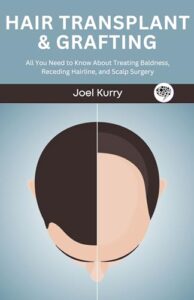
Precision guides and specialized surgical tools transform hairline restoration into an art form.
You’ll find that modern scalp surgery kits include measurement tools, implanter pens, and standardized guides that guarantee consistent spacing and natural density patterns.
These instruments help surgeons achieve 90-95% graft survival rates while maintaining proper angulation and symmetry.
The guides reduce human error during recipient site creation, making your results appear virtually indistinguishable from natural hair growth patterns, which is a key factor in achieving a natural look with proper angulation and symmetry.
Best For: Individuals seeking natural-looking hairline restoration and long-term hair transplant results performed by skilled surgeons using advanced surgical guides and tools.
- Not suitable for everyone; candidacy depends on donor hair and scalp health.
- Advanced tools and robotic systems can increase the overall procedure cost.
- Curly or coarse hair may require special approaches, complicating the process.
- High precision tools and guides ensure natural density, symmetry, and angulation.
- Advanced techniques deliver graft survival rates of 90–95% and minimal discomfort.
- Reduced human error and consistent results across multiple sessions.
4. Afro Hair Transplant Guide To Turkey

Working with Afro-textured hair presents unique challenges that require specialized expertise.
This thorough guide breaks down the intricacies of hair transplantation for curly, kinky, and coily hair types in Turkey.
You’ll discover why Turkish clinics excel at handling curved follicles and maintaining natural curl patterns.
The guide covers FUE and DHI techniques specifically adapted for Afro hair, clinic selection criteria, and realistic expectations.
With Turkey’s 90% success rate and substantially lower costs ranging from $2,400 to $5,000, you’ll understand why it’s become the go-to destination for ethnic hair restoration worldwide.
Best For: Individuals with Afro, curly, kinky, or wavy hair seeking a specialized, affordable, and high-success hair transplant experience in Turkey.
- Clinics have extensive experience with textured hair, ensuring natural curl patterns and hairlines.
- Advanced techniques like FUE and DHI minimize scarring and produce natural-looking results.
- Costs are significantly lower than in the US or Europe, often including all-inclusive care packages.
- Not every clinic is equipped to handle Afro hair, requiring careful selection and research.
- Technical demands of extraction and implantation increase potential for complications if not performed by experts.
- Full results take 10-12 months, requiring patience and diligent aftercare for optimal growth.
5. Hair Transplant in Turkey Experts

When you’re exploring Turkey’s hair transplant landscape, you’ll find world-class surgeons who’ve transformed the industry.
Dr. Serkan Aygin, Europe’s Best Hair Transplant Surgeon in 2019, has completed over 10,000 procedures with 25+ years of expertise.
Dr. Levent Acar leads Istanbul’s top clinics, while Dr. Emrah Cinik specializes in advanced Sapphire FUE and DHI techniques.
These experts consistently achieve 90%+ success rates, combining cutting-edge technology with affordable pricing that’s substantially lower than Western countries without compromising quality standards.
Best For: People seeking an affordable, high-quality hair transplant with experienced surgeons and modern technology, especially those considering traveling abroad for treatment.
- Choosing a reputable clinic requires navigating misleading online reviews
- Travel to Turkey is necessary, which can involve time and additional planning
- Results depend on individual factors like donor hair quality and post-op care compliance
- Access to internationally recognized surgeons known for natural results and high success rates
- Affordable all-inclusive packages with advanced technology and comprehensive patient care
- Facilities cater to international patients, offering convenience and streamlined logistics
Hair Transplant Techniques
You’ll find four main techniques available for hair transplant procedures, each offering different advantages for restoring your receding hairline.
Modern methods like FUE and DHI provide more precise results with minimal scarring, while traditional FUT remains effective for patients needing larger graft numbers.
Follicular Unit Extraction (FUE) Method
Understanding follicular unit extraction begins with recognizing it’s your most popular hair transplant option today.
FUE advantages include minimal scarring and faster recovery, but FUE limitations involve higher costs and potential donor depletion over time.
This hairline surgery technique extracts individual follicles, offering superior graft survival rates compared to strip methods.
DHI vs FUE discussions often favor FUE for receding hairline cases due to its precision and natural results in hair restoration procedures.
Follicular Unit Transplantation (FUT) Technique
Follicular Unit Transplantation (FUT) involves Strip Excision from your donor area, creating a linear scar that requires Trichophytic Closure techniques.
While Scarring Concerns exist, this hair transplant method offers excellent Graft Survival rates for receding hairline restoration.
FUT Refinement allows surgeons to harvest more grafts efficiently, making this hairline surgery cost-effective for extensive hair restoration needs.
Robotic Hair Transplantation Systems
Robotic hair transplantation systems use advanced AI algorithms and 3D mapping technology for robotic precision in follicular unit extraction FUE procedures.
These automated systems reduce downtime by making smaller incisions with less bleeding compared to manual hair transplant techniques.
Studies show improved graft survival rates due to consistent extraction methods.
Cost analysis reveals higher upfront expenses, though future advancements promise greater accessibility for receding hairline hair restoration treatments.
Both ARTAS and NeoGraft are robotic FUE systems used in these procedures, utilizing robotic precision for follicular unit extraction.
Direct Hair Implantation (DHI) Procedure
Direct Hair Implantation revolutionizes hair transplant procedures by combining extraction and implantation in one seamless step.
The Choi Implanter Pen enables precise graft placement at ideal angles, achieving superior Hairline Precision compared to traditional methods.
DHI Advantages include higher Graft Survival Rates and minimal handling of follicles, delivering exceptional results for receding hairlines.
This advanced hair loss treatment, though reflecting its premium technology and specialized training requirements in DHI Cost Factors, achieves outstanding outcomes.
Planning and Preparation
Successful hair transplant outcomes depend heavily on thorough planning and preparation before your procedure.
Your surgeon will evaluate your hair loss pattern, assess your candidacy, design your new hairline, and provide specific pre-operative instructions to guarantee the best results.
Initial Consultation and Hair Loss Assessment
Your hair transplant consultation begins with documenting your hair loss history, including family patterns and timeline progression.
The surgeon performs a thorough scalp examination, evaluating donor area density and recipient site characteristics.
You’ll discuss patient expectations and available treatment options while the specialist conducts candidacy evaluation to determine if you’re suitable for hair transplant procedures targeting your receding hairline.
Determining Candidacy for Hair Transplantation
Successful hair transplant candidates require stable hair loss patterns for at least two years, adequate donor hair quality with minimum 80 follicles per cm², and good overall health.
Age considerations favor patients between 30-49, while medical conditions like diabetes or autoimmune disorders may disqualify candidates.
Thick, straight hair often leads to better outcomes, as it provides superior hair coverage.
Realistic expectations about achievable density and coverage determine long-term satisfaction with your receding hairline restoration results, which is crucial for a successful transplant, considering factors like hair coverage and overall health.
Designing a Natural-Looking Hairline
Creating your perfect hairline design requires balancing artistry with surgical precision to achieve natural-looking results.
Your surgeon will consider your facial proportions, age, and existing hairline shape to develop a customized restoration plan.
Key elements of natural hairline design include:
- Hairline Shape: Creating subtle irregularities and micro-variations that mimic natural growth patterns
- Density Gradient: Placing single-hair grafts at the front edge with increasing density behind for seamless integration
- Temporal Integration: Carefully designing temple points to blend with existing hair and facial contours
- Widows Peak: Maintaining or recreating natural peaks while avoiding overly straight or artificial-looking lines.
Your surgeon will map out the new hairline using your facial measurements and bone structure as guides.
This hairline restoration process guarantees proper graft placement and establishes realistic expectations for your hair transplant outcome.
Pre-operative Instructions and Medication Adjustments
Before scheduling your hair transplant procedure, you’ll need thorough medical clearance to guarantee favorable surgical outcomes.
Blood work and pre op tests help identify potential complications that could affect healing.
| Required Tests | Purpose |
|---|---|
| Complete Blood Count | Check for anemia or infection |
| Liver Function Panel | Assess medication processing ability |
| Coagulation Studies | Evaluate bleeding risk factors |
Your surgeon will review current medications during preoperative care, adjusting blood thinners and supplements that interfere with clotting.
Surgery prep includes stopping aspirin, vitamin E, and herbal remedies two weeks before your receding hairline treatment.
Medical clearance from your primary physician may be required for patients with diabetes, heart conditions, or other chronic illnesses.
Proper hair transplant preparation through medication adjustments and pre op tests substantially reduces surgical risks and improves graft survival rates.
Hair Transplant Procedure
You’ll experience the actual hair transplant procedure in four key stages that restore your natural hairline.
The surgeon administers local anesthesia, harvests healthy hair follicles from your donor area, creates precise recipient sites, and carefully places each graft for ideal results.
Anesthesia and Pain Management During Surgery
Most hair transplant procedures use local anesthesia to numb your scalp completely.
Your surgeon will inject lidocaine or similar numbing agents directly into the donor and recipient areas. You’ll remain awake but feel no hair transplant pain during the procedure.
Some clinics offer sedation methods for anxious patients. This approach guarantees surgical comfort while allowing you to communicate with your medical team throughout the hair transplant anesthesia process.
The medical team relies on advanced anesthesia machines to administer the anesthesia safely and effectively.
Donor Area Harvesting Techniques
Once you’re comfortable and numb, your surgeon carefully prepares the donor area for harvesting.
FUE Methods involve extracting individual follicular units using specialized punches, while follicular unit transplantation removes a strip from the scalp.
Proper scalp preparation guarantees maximum graft survival during hair extraction. Your surgeon selects the healthiest follicles from the donor site for successful graft harvesting.
Creating Recipient Sites for Hair Grafts
Precision transforms success when your surgeon creates recipient sites for hair grafts.
These tiny incisions determine how natural your new hairline looks and how well grafts survive the transplantation process.
Your surgeon follows these critical steps during site creation:
- Hair Angulation – Sites angled to match your natural hair growth direction
- Recipient Density – Proper spacing promotes maximum graft survival rates
- Hairline Design – Strategic placement creates natural-looking results
- Follicular Unit Extraction compatibility – Sites sized for individual grafts
- Graft Placement preparation – Clean incisions promote healing
Graft Placement and Artistic Considerations
Once sites are prepared, you’ll see your surgeon’s artistic technique come alive through precise graft placement.
Each follicular unit extraction requires careful attention to hair angle, follicle depth, and transplant density to achieve natural hairline aesthetics.
Your surgeon matches existing hair patterns while considering graft design principles.
Proper placement creates seamless integration between transplanted and native hair.
This artistic approach distinguishes exceptional results from merely adequate ones in modern hair transplant techniques.
Recovery and Aftercare
Your hair transplant recovery begins immediately after you leave the clinic, and following proper aftercare instructions will determine your final results.
The next few weeks require careful attention to your scalp’s healing process, but most patients find the recovery more manageable than they initially expected, which makes the overall experience more bearable.
Post-operative Care Instructions
Your recovery journey begins the moment you leave the clinic. Proper hair transplant aftercare determines your success and minimizes hair transplant complications during the vital wound healing phase.
Effective post op care products can aid in the healing process.
- Keep your scalp dry for 48 hours – avoid washing to prevent infection and protect newly placed grafts from dislodging during initial healing
- Sleep elevated on multiple pillows – reduces swelling and prevents accidental rubbing that could damage transplanted follicles or worsen hair transplant scarring
- Follow prescribed medication schedule – take antibiotics as directed and use gentle cleansing solutions to support scar care and prevent complications during hair transplant recovery
Managing Pain and Discomfort After Surgery
Pain management after hair transplant surgery typically involves prescribed medications and simple home remedies.
Your doctor will recommend over-the-counter pain relievers or stronger prescription options for the first few days.
Applying ice packs reduces swelling while keeping your head elevated during sleep minimizes discomfort.
Following proper medication use and post op care helps guarantee smoother hair transplant recovery with effective pain management strategies.
Effective use of pain relief meds, such as those found in pain relief products, can substantially reduce post-surgical discomfort, ensuring a more comfortable recovery with proper medication.
Timeline for Hair Growth After Transplantation
Following your surgical discomfort, you’ll experience distinct growth phases during hair transplant recovery.
Transplanted hairs shed within 2-4 weeks—this shock loss is normal as follicles enter dormancy.
New hair growth begins around months 3-4, appearing fine initially.
Significant thickening occurs between months 6-9 as follicle maturation progresses.
Full hair transplant results emerge by 12-18 months, with regrowth patterns varying individually based on your unique recovery timeline, influenced by overall recovery.
Potential Complications and How to Address Them
While most patients experience smooth healing, complications can occur.
Infection affects less than 1% of patients but requires immediate antibiotic treatment if you notice persistent redness, swelling, or discharge.
Shock loss temporarily affects 10-15% of patients as existing hair sheds from surgical stress.
Scarring issues are more common with FUT procedures, while follicle damage and graft failure can result from poor technique or inadequate aftercare.
Proper scalp health management is essential to minimize the risk of these complications and promote a healthy environment for hair growth.
Cost and Alternatives
Understanding the financial investment and exploring your options helps you make an informed decision about addressing your receding hairline.
While hair transplants require a significant upfront cost, alternative treatments may offer more budget-friendly solutions depending on your specific needs and goals, which can help in making a decision about alternative treatments.
Factors Affecting Hair Transplant Pricing
Several factors determine what you’ll pay for your hair transplant procedure.
Understanding these elements helps you budget effectively and choose the right option for your needs.
Key pricing factors include:
- Graft Costs – Number of grafts needed based on your hair loss extent
- Surgeon Fees – Experience level and reputation of your chosen specialist
- Clinic Location – Geographic area substantially impacts hair transplant cost
- Procedure Type – FUE, FUT, and DHI hair transplant methods vary in hair transplant pricing
Insurance Coverage typically doesn’t apply since transplants are cosmetic.
Research hair transplant clinic options thoroughly, as quality affects long-term results more than initial savings.
Average Costs for Different Transplant Techniques
Across different hair transplant methods, you’ll find significant variations in transplant fees and procedure rates.
FUE typically costs $6.57 per graft in the US, while FUT averages $3-7 per graft.
DHI commands premium hair pricing at $10,000-15,000 per procedure.
| Technique | Average Cost Range |
|---|---|
| FUT (Strip Method) | $4,000 – $15,000 |
| FUE (Individual Extraction) | $13,149 (2,000 grafts) |
| DHI (Direct Implantation) | $10,000 – $15,000 |
Insurance Coverage for Hair Restoration Procedures
Most hair transplant insurance doesn’t cover receding hairline procedures since they’re considered cosmetic. However, you’ll find coverage exceptions for trauma-related hair loss, medical conditions, or gender-affirming care.
- Policy Exclusions: Standard insurance types exclude cosmetic hair transplant procedures
- Claim Process: Requires medical documentation proving necessity beyond aesthetics
- Coverage Limits: When approved, hair transplant reimbursement rarely covers full costs
- Premium Costs: Specialized hair transplant insurance policies aren’t widely available
Financing Options and Payment Plans
Most clinics don’t offer direct hair transplant financing but connect you with third-party lenders like CareCredit and Lending Club.
These loan options provide promotional 0% APR periods or fixed payment plans starting around $150-350 monthly. Personal loans from banks offer another path, with typical hair transplant cost ranging $4,000-15,000.
Payment plans make procedures accessible without depleting savings, though insurance coverage remains limited for cosmetic treatments. Understanding the hair highlight costs can also help in budgeting for other cosmetic procedures, considering the overall cosmetic treatments and their financial implications.
Alternative Treatments for Receding Hairline
Beyond surgical intervention, you can explore several proven nonsurgical hair restoration options.
Minoxidil treatment stimulates hair growth when applied twice daily, while finasteride medication blocks DHT hormone production.
PRP therapy uses your blood’s platelets to strengthen follicles.
Low laser therapy improves scalp circulation, and scalp micropigmentation creates fuller-looking density through cosmetic tattooing techniques, utilizing a method that can be considered a form of cosmetic treatment.
Frequently Asked Questions (FAQs)
Can hair transplants fix receding hairlines?
Like a skilled architect rebuilding a foundation, you can absolutely restore your receding hairline through hair transplant surgery.
The procedure achieves a 90-95% success rate by relocating healthy follicles to thinning areas, creating permanent, natural-looking results.
Can a hair transplant regrow the hairline?
Yes, you can regrow your hairline through transplant surgery. The procedure moves healthy follicles from donor areas to recreate your natural hairline, with visible results appearing after 6-9 months.
Is 1500 grafts enough for a hairline?
For mild to moderate recession, 1500 grafts can effectively restore your hairline. However, deeper recession or wider temples might need 1800-2000 grafts for ideal density and natural-looking results.
Can hair regrow on a receding hairline?
Think of your hairline like a garden facing winter – while some natural regrowth can happen, don’t expect miracles.
Hair can’t regrow on completely bald areas, but early thinning may respond to treatments like minoxidil or finasteride, slowing further loss.
Do hair transplants fix receding hairlines?
Hair transplants effectively restore receding hairlines by relocating healthy follicles to thinning areas. You’ll see natural-looking results with 90-95% success rates, achieving permanent restoration that lasts decades.
How much do hair transplants cost for receding a hairline?
Picture yourself staring at the mirror, wondering about the price of transformation. You’ll typically pay $4,000 to $12,000 for receding hairline restoration, depending on recession severity and required grafts.
Can hair regrow on receding hairline?
Unfortunately, you can’t naturally regrow hair on a receding hairline once it’s permanently lost. However, treatments like minoxidil can slow further loss and strengthen existing follicles for modest improvement.
Do hairline transplants last?
Like planting seeds in fertile soil, your transplanted hairline becomes a permanent part of your landscape.
Results typically last 10-15 years or more, with 90-95% success rates providing natural-looking coverage that grows and ages with you.
Can I dye my hair after a transplant?
You can dye your hair after a transplant, but timing matters. Wait at least 4-6 weeks for grafts to heal properly. Use gentle, ammonia-free dyes and avoid harsh chemicals initially.
Will a hair transplant affect future hair loss?
A hair transplant won’t prevent future hair loss in untreated areas. Your transplanted hair remains permanent, but you’ll likely need additional procedures or medications to address ongoing thinning.
Conclusion
Reclaiming your hairline through transplantation isn’t just about vanity—it’s about rebuilding the foundation of your confidence.
You’ve learned about the different techniques, costs, and recovery expectations, which enables you to make an informed decision about restoring your hairline.
Remember, choosing an experienced surgeon and having realistic expectations are your keys to achieving natural-looking results that’ll last a lifetime.
- https://pmc.ncbi.nlm.nih.gov/articles/PMC11930656/
- https://www.ibrainrobotics.net/post/latest-hair-replacement-technology
- https://ishrs.org/follicular-unit-extraction-fue-manual-and-powered-device-assisted/
- https://emrahcinik.com/hair-transplantation-for-a-receding-hairline/
- https://drbonaros.com/fue-hair-transplant-technology/


